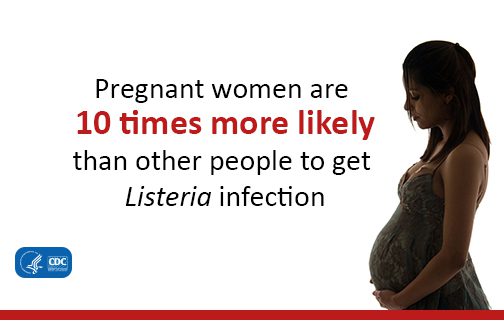Contents
Listeriosis, what is it?
Like toxoplasmosis, listeriosis is an infectious disease (fortunately rare!) Caused by bacteria found in food. But Listeria monocytogenes – that’s its name – also lodges on the utensils you use for cooking, in your cupboards and even in fridges and freezers (it is very resistant to cold!). Pregnant women, newborns, the elderly … individuals whose immune system is weakened or modified are particularly exposed to the risk of contracting the disease. Listeriosis becomes problematic during pregnancy, the bacteria that can reach the fetus by crossing the placental barrier or via natural routes, during childbirth. Each year, around 400 cases of listeriosis are recorded in France, or 5 to 6 cases per million inhabitants per year.
Listeriosis and pregnancy: symptoms, treatments and complications
Listeriosis can cause serious complications during pregnancy. Headaches, stiff neck, severe fatigue … Symptoms of listeriosis strongly resemble those of the flu. At the first signs, we go straight to our gynecologist or attending physician. A blood test will determine the presence of the bacteria. If so, a antibiotic treatment, suitable for pregnant women, is administered for a period of approximately fifteen days. In other cases, Listeria infection goes unnoticed. In other words, you can infect your baby without noticing it.
When the bacteria manage to reach the fetus, the consequences are often serious: miscarriage, premature delivery, even death in utero of the baby. If the pregnancy could be brought to term, the danger is not completely eliminated. The newborn, contaminated in the womb of its mother, can declare sepsis or meningitis within a few days of its birth, or suffer from respiratory distress.
How to avoid listeriosis during pregnancy?
To protect themselves from listeriosis, expectant mothers are strongly advised to do without certain foods and adopt new reflexes. Here are the foods to avoid:
- All cheeses made from raw milk, soft, blue-veined (Roquefort, Bleu d’Auvergne, etc.), bloomy rind (Brie and Camembert), and even melted. They must be cooked so as not to present any danger (for example, in a gratin, baked at over 100 ° C);
- Ready-to-use salad and other raw vegetables in a bag;
- Parsley, even washed (the Listeria bacteria clings to the stems! For other aromatic herbs, be sure to wash them well);
- Sprouted seeds, of the soybean type;
- Raw meats, foie gras and all charcuterie products;
- Raw fish, raw shellfish, crustaceans and their derivatives (surimi, tarama, etc.).
The right actions on a daily basis
- Wash fruits and vegetables conscientiously, or eat them preferably cooked;
- Thoroughly cook all foods of animal origin, especially meat and fish (forget the rare rib steak and sushi!);
- Wash your fridge once every month with a sponge, preferably a new one, and bleach (or white vinegar and baking soda, less toxic!);
- Maintain the temperature of your refrigerator between 0 ° C + 4 ° C.
- Do not use previously used kitchen utensils to handle fish or raw meat;
- Consume the food the same day it is opened (ham in plastic, for example);
- Keep raw foods separate from cooked foods to avoid cross-contamination;
- Strictly respect the use-by dates;
- Thoroughly reheat food leftovers and cooked dishes at high temperature, Listeria monocytogenes being destroyed at 100 ° C;
- Be particularly vigilant about the contents of the plate in restaurants or with friends!










